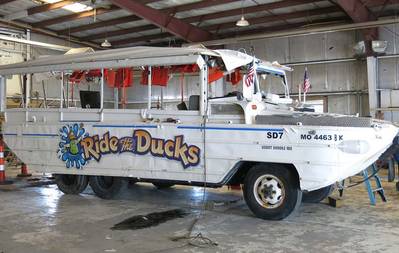NTSB Issues Duck Boat Safety Recommendations
U.S. federal officials are calling for new safety rules following the fatal sinking of a Missouri amphibious passenger vessel in July 2018.
Seventeen of the 31 people aboard the modified WWII DUKW amphibious passenger vessel, or "duck boat", Stretch Duck 7 died, when the vessel sank during a rapidly developing high-wind storm on Table Rock Lake near Branson, Mo.
As part of its ongoing investigation into the July 19, 2018 accident, the National Transportation Safety Board (NTSB) issued a marine safety recommendation report on Wednesday that calls upon the U.S. Coast Guard to require new safety measures, including rules to ensure sufficient reserve buoyancy for DUKW amphibious passenger vessels, and to require the removal of canopies, side curtains and their associated framing, while underway, for those without sufficient reserve buoyancy.
NTSB's latest safety recommendations are not new. Since 1999 the investigative agency responsible for civil transportation accident investigation has issued 22 safety recommendations related to modified WWII DUKW amphibious passenger vessels. Of those 22, only nine have been implemented, and another four are pending and classified open – acceptable response.
The remaining nine had not been implemented and were classified open – unacceptable response, closed – unacceptable action or closed – unacceptable action/no response received. NTSB believes implementing these safety recommendations could have saved lives.
“Lives could have been saved, and the Stretch Duck 7 accident could have been prevented had previously issued safety recommendations been implemented,” said NTSB Chairman Robert L. Sumwalt.
Safety recommendation M-00-5 addressed the need for DUKWs to have adequate reserve buoyancy but was classified closed – unacceptable action/no response received, eight years after its issuance. The NTSB believes the failure to implement previous safety recommendations related to reserve buoyancy for DUKWs contributed to the sinking of the Stretch Duck 7.
Similarly, the failure to implement the previously issued recommendation concerning fixed canopies, following the fatal, 1999 Miss Majestic DUKW accident, likely increased the number of fatalities resulting from Stretch Duck 7 sinking, NTSB said.
“The NTSB’s 1999 investigation of the another DUKW, the Miss Majestic, also identified the lack of reserve buoyancy and the dangers of canopies as safety issues. In 2008, recommendations from that accident addressing these safety issues were classified ‘Closed-Unacceptable Action’ due largely to inaction. Twenty years later, the same risk exists on these vessels, and that is unacceptable,” said Sumwalt. “It is imperative that the United States Coast Guard adopt these life-saving recommendations now.”
The NTSB said its investigation into the sinking of the Stretch Duck 7 is ongoing and probable cause has not yet been determined, however, information gained through the investigation warranted the issuance of the safety recommendation report before the investigation is completed. The agency will issue a determination of probable cause for this accident when the investigation concludes.















